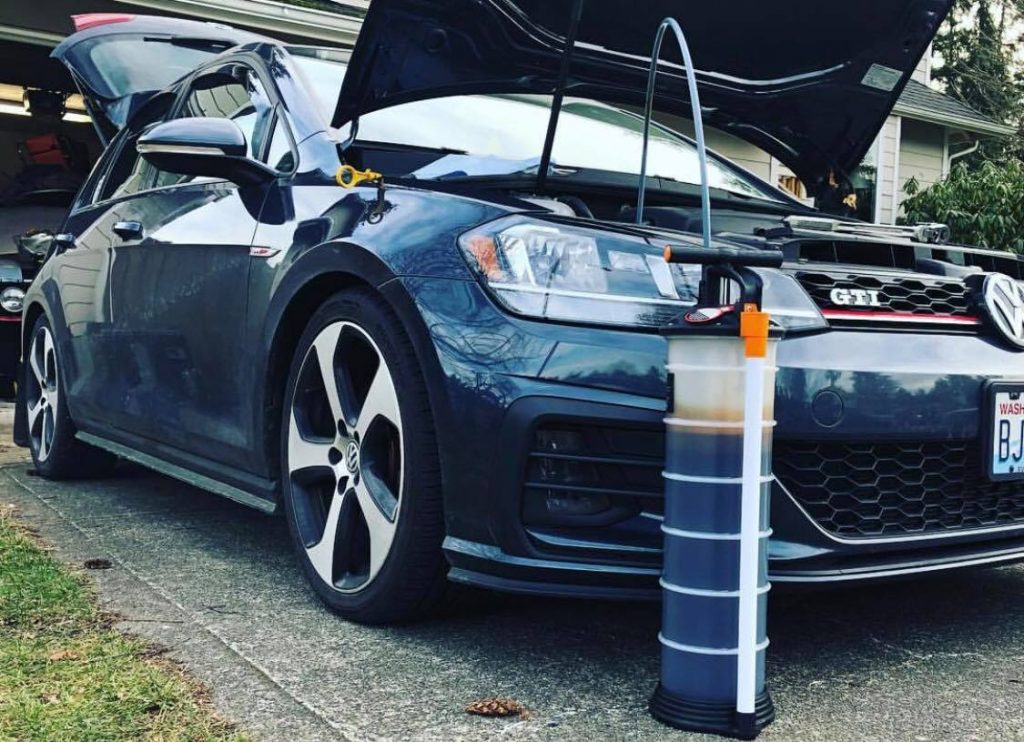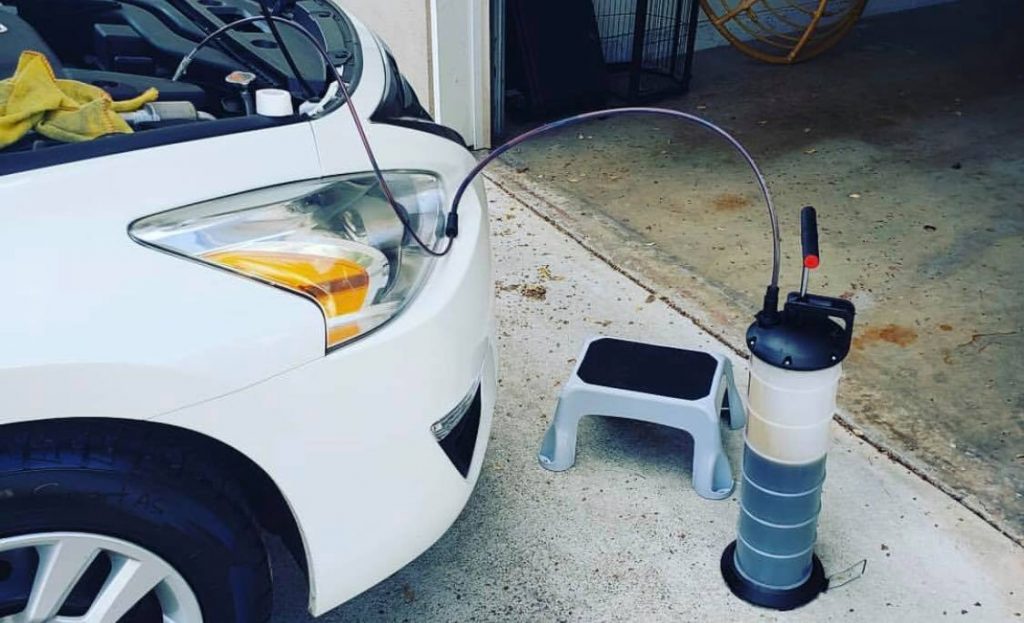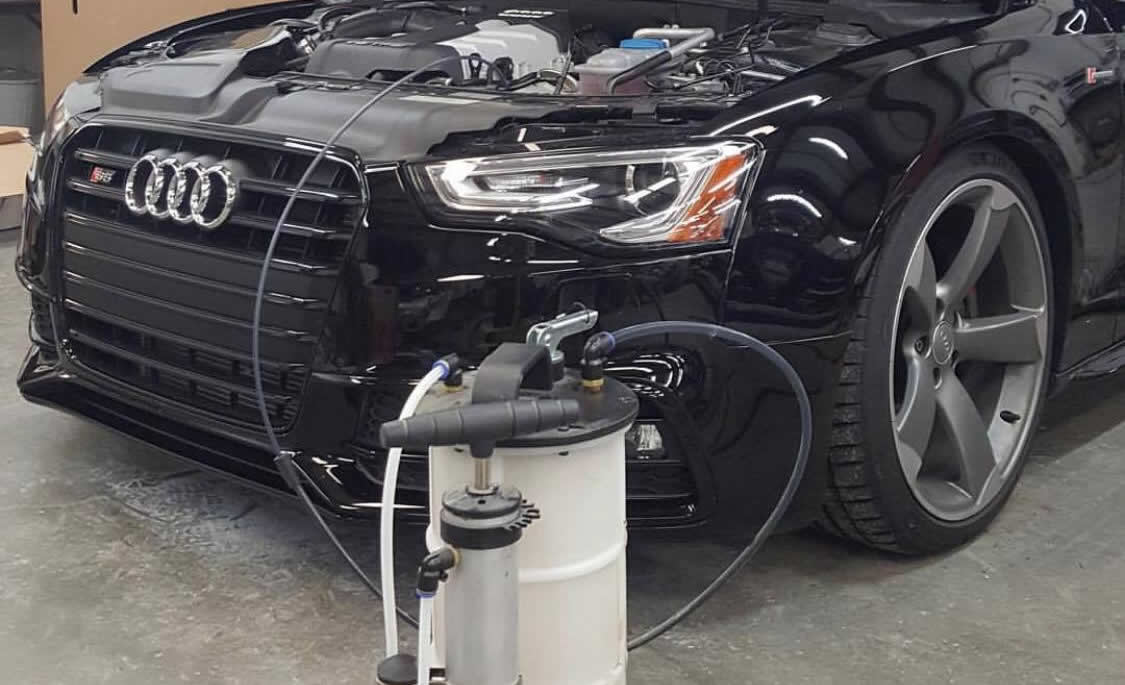Using an oil extractor pump to vacuum old fluid from your vehicle is the best option to improve efficiency and reduce mess. They are available as a manual hand operated pump or a pneumatic model that connects to an air compressor.
The best oil extractor is the Mityvac 7201 Fluid Evacuator Plus, which has an 8.8 liter tank for collecting the majority of automotive fluids.
Oil extractors remove the hassle, complexity and mess from the traditional method of replacing old oils within your car. They are a garage tool that is relatively affordable and can be used multiple times for a range of fluids.
Table of Contents
Best Oil Extractor
| Oil Extractor | Type | Capacity |
|---|---|---|
| Mityvac 7201 Evacuator Plus | Manual Pump | 8.8 Liters |
| EWK Extractor Pump | Pneumatic/Manual | 6.5 Liters |
| OEMTOOLS 24389 | Pneumatic/Manual | 5.3 - 9.6 Liters |
| Mityvac 7300 PneumatiVac | Pneumatic | 8.8 Liters |
| Air Power America Topsider | Manual Pump | 9.1 Liters |
Whilst changing the motor oil in your car, it will often involve crawling around underneath your car. However, using an oil extractor is far easier as the flexible hoses vacuums all the old fluid in a matter of minutes into the reservoir.
You will want to ensure that the reservoir capacity exceeds the amount of fluid you intend to remove for maximum efficiency. Most have an automatic shut off functionality to avoid overfilling but you will still need to empty the old oil.
Below is a list of the best oil extractors that are available as a pneumatic or manually operated unit and is suitable for most automotive fluids.
Mityvac 7201 Fluid Evacuator Plus
Mityvac are a brand that are known for their brake bleeder kits but they also produce a range of oil extractors. The 7201 Fluid Evacuator Plus is one of the most popular available and features a 8.8 liter tank for collecting a large amount of fluid.
Included within the complete package is three 5 feet long dipstick tubes, three tube adapters and a quick drain pour spout.
Other features of the Mityvac 7201 Fluid Evacuator Plus include:
- Bi-functional manual unit
- Durable polyethylene reservoir
- Automatic flow control valve
- Suitable for most automotive fluids
- Very simple to use
Although it comes with a premium price, it is a high quality oil extractor that will last for many years. It does lack a vacuum pressure gauge but this can easily be added to the configuration, which will allow you to monitor the pressure.
Check it OutEWK Manual and Automatic Oil Extractor
Another popular oil extractor is by the EWK brand and it has the ability to extract fluid manually or by using a compressor. This 2-way usage allows you to work freely inside the garage as well as outdoors for other applications.
If you intend to use an air compressor with this oil extractor, it will be able to extract fluid at an impressive 1.6 liters per minute.
Other features of the EWK Oil Extractor include:
- 6.5 liter fluid capacity
- Average air consumption of 2.5 CFM
- Safety lock design with a spout
- Includes extension tube and wire
- Suitable for multiple applications
Overall, it is a versatile oil extractor that can be manually pumped or connected to a compressor via a 1/4 inch coupler. The brand also offer a range of additional spare tubes and other accessories to further improve the usability of the extractor.
Check it OutOEMTOOLS 24389 Manual Oil Extractor
The oil extractor by OEMTOOLS is available in a range of different configurations to suit your requirements. It can be purchased as a manual or dual functioning tool with the addition of a pneumatic fluid extraction function.
Depending upon the amount of fluid you intend on extracting, the brand provides a choice of 5.3, 6.0, 8.0 and 9.5 liter tank capacities.
Other features of the OEMTOOLS Fluid Extractor Pump include:
- Venturi and pumping handle
- Leak-proof bottom
- Suitable for a range of fluids
- Overflow shut off valve
- Over sized pumping handle for ease of use
- 6.5 CFM air consumption in pneumatic mode
- Includes a 5 foot suction hose and 2 adapters
The OEMTOOLS 24937 is an excellent all-round oil extractor that ticks every box in terms of performance and value. It is suitable for most automotive fluid types and includes clever features such as an automatic shut off valve to prevent spillages.
Check it OutMityvac 7300 Pneumatic Oil Extractor
Mityvac also produce a pneumatic alternative known as the 7300 model, which uses the same 8.8 liter reservoir. Included within the package is a 5 feet long flexible hose, dipstick tubes and even a universal brake-bleeding adapter.
In order to improve the stability of the extractor, the venturi is base mounted, which prevents movement during extraction.
Other features of the Mityvac 7300 Pneumatic Oil Extractor include:
- Pneumatic fluid removal
- Automatic shut off valve
- Suitable for most automotive fluids
- Durable polyethylene reservoir
- Easy to setup and use
Overall, it is a high performing pneumatic fluid extractor that comes with the backing of the reputable Mityvac brand. It does lack having a manual pump but if you are primarily using it with pressurized air, this will not be a problem.
Check it OutAir Power America 5060TS Oil Extractor
If you require an affordable oil extractor that is easy to use, the Air Power America 5060TS is the best option. It uses a manually operated pump to extract old oil through the dipstick tubes and then into the 9.1 liter reservoir.
Unlike other manual alternatives, the Topsider uses a 12 inch wide stance to provide a stable based whilst pumping the handle.
Other features of the Air Power America 5060TS Topsider include:
- Vacuum pressure without electricity
- Suitable for a range of fluids and applications
- Easy to setup and use
- Portable design
- 9.1 liter capacity
It is a multi-purpose vacuum pump that is by far the most popular available due to its low cost and easy to use operation. Overall, if you are on a budget and require a versatile extractor, the Air Power America 5060TS Topsider will not disappoint.
Check it OutOil Extractor Buying Guide
An oil extractor is one of the most useful tools within a garage and are used by professionals worldwide. Rather than getting messy underneath your car, you can simply vacuum old oil into a reservoir and recycle it with ease.
They are designed to work with the majority of automotive oils such as synthetic motor oil, transmission fluid, brake fluid and much more.
To help you make an informed buying decision, we have produced the below guide regarding oil extractors.

Types of Extractors
There are three main types of oil extractors that include manual, pneumatic and electric operated pumps. The most popular type is the manual oil extractor, which is operated by a hand pump. It doesn’t use electricity and simply requires you to pump until there is enough vacuum available for suction.
Using a pneumatic oil extractor is ideal for those with an air compressor and offers the most amount of convenience. Many brands often include both pneumatic and manual functionality, which allows you to use either method.
The electric alternative connects to a car battery or an outlet depending upon the type of extractor. It is the least popular due to the complexity of the setup and lack of movement as you are connected to a power cord.
Reservoir Capacity and Quality
To ensure that you can extract all the oil without overfilling, you will want a large reservoir capacity. The majority range from as small as 5 liters to as big as 10 liters.
Due to the hazardous fluids that will be contained within the reservoir, its important that it is durable and does not corrode. The majority of brands will use a polyethylene material for the construction of the reservoir.
Portability
Although portability may not be the first factor to consider, it is certainly something that will make a big difference. This is because once the reservoir is full of oil, it needs to be easy to transport as this will reduce the chances of any spillages.
Safety
To avoid you coming into contact with any harmful fluids, you will want to ensure the extractor is safe to use. Functionality such as automatic shut off valves that prevent overfilling are highly desirable. Another safety feature are suction pipes that are flexible and long enough to reach all of the oil to be removed without any spillage.
How to Use an Oil Extractor
Depending upon the fluid you are extracting will determine the steps you take to remove the fluid. Below are the steps required to replace motor oil with an extractor.
- Run the engine for a few minutes.
- Insert the tube into the oil dipstick.
- Keep pushing the tube until it stops.
- Setup the oil extractor ready for suction.
- Connect the extractor pump.
- Allow at least 10 minutes for removal.
It is important to note that the setup of the extractor will differ depending upon the type of extractor you are using. Electric types need to connect to the battery, pneumatic will need to attach to an air compressor and the manual operated will need to be pumped.
The amount of time that is required will determine upon the vacuum pressure and amount of fluid to be removed. For example, there is far less power steering fluid to remove than motor oil. Air bubbles within the suction tubes is an indicator that the extraction process is almost finished.

Drawbacks
The use of an extractor to remove old oil saves time and is less messy but does come with drawbacks. For example, if you are using it remove old motor oil, it may not completely remove all the oil within your engine. Fine metals and oxidation can settle in the oil sump, which is very hard to remove with an extractor.
We recommend that after 2 or 3 extraction oil changes that you use the traditional method of draining the oil from the sump. This will ensure that the oil is completely clear of any particles that may remain in the oil.
Conclusion
The traditional method of replacing your oil is messy, time consuming and can often go wrong. Purchasing the best oil extractor that you can get your hands on will complete transform the way you replace oil. They are a worthwhile investment that are used by many professional garages for removing a range of automotive fluids.
All of our recommendations are suited for a range of budgets and feature pneumatic and manual operated pumps. Unless you have an air compressor, the best option would be to choose a manual fluid extractor.






